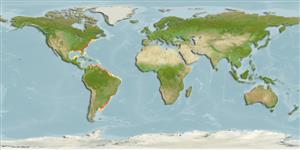Elasmobranchii (tubarões e raias) (sharks and rays) >
Myliobatiformes (Stingrays) >
Myliobatidae (Eagle and manta rays)
Etymology: Myliobatis: Greek, mylo = mill + Greek, + Greek, batis,-idos = a ray (Raja sp.) (Ref. 45335).
More on author: Lesueur.
Environment: milieu / climate zone / depth range / distribution range
Ecologia
marinhas; estuarina bentopelágico; intervalo de profundidade 0 - 100 m (Ref. 57911), usually 1 - 10 m. Subtropical; 43°N - 42°S, 97°W - 33°W
Western Atlantic: continental waters from Cape Cod to southeastern Florida (?) in the USA; also southern Brazil to Argentina (Ref. 58839). Reported (but not known for certain) from Gulf of Mexico, Florida and Caribbean islands, and northern South America. Often confused with Myliobatis goodei (Ref. 3173).
Length at first maturity / Tamanho / Peso / Idade
Maturity: Lm 65.0, range 60 - 70 cm
Max length : 129 cm WD macho/indeterminado; (Ref. 49746); common length : 70.0 cm WD macho/indeterminado; (Ref. 5217)
Descrição breve
Morfologia | Morfometria
Disk broad with long sharply pointed wings and projecting snout. Tail very long, Few middorsal spines on disk in adults (Ref. 7251). Greyish, reddish chocolate or dusky brown above. Lower surface either pure white or whitish. Teeth green (Ref. 6902).
Found frequently in coastal waters to 10 m depth, mainly in shallow estuaries. Capable of traveling long distances, occasionally leaps out of the water. Swims in midwater. Cruises slowly over the bottom, rooting out bivalves with its beak and wings when feeding (Ref. 7251). Ovoviviparous (Ref. 50449).
Exhibit ovoviparity (aplacental viviparity), with embryos feeding initially on yolk, then receiving additional nourishment from the mother by indirect absorption of uterine fluid enriched with mucus, fat or protein through specialised structures (Ref. 50449).
Robins, C.R. and G.C. Ray, 1986. A field guide to Atlantic coast fishes of North America. Houghton Mifflin Company, Boston, U.S.A. 354 p. (Ref. 7251)
Categoria na Lista Vermelha da IUCN (Ref. 130435)
Ameaça para o homem
Harmless
Utilização humana
Pescarias: pouco comercial
Mais informação
ReferênciasAquaculturaPerfil para aquaculturaEstirpesGenéticaElectrophoresesHereditariedadeDoençasProcessamentoNutrientsMass conversion
Ferramentas
Warning: mysqli::__construct(): (HY000/1040): Too many connections in /var/www/html/includes/speciessummary.lib.php on line 2414
Can't connect to MySQL database fbquizv2. Errorcode: Too many connections
